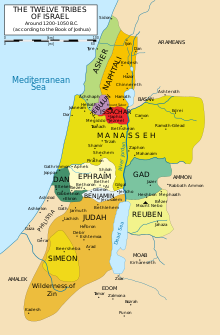
Back Tien Verlore Stamme Afrikaans الأسباط العشرة المفقودة Arabic غیب اولموش اون قبیله AZB Десет изгубени колена Bulgarian দশ নিখোঁজ বংশ Bengali/Bangla Verlorene Stämme Israels German Dek Perditaj Triboj Esperanto Diez tribus perdidas Spanish ده قبیله گمشده Persian Israelin kadonneet heimot Finnish
| Tribes of Israel |
|---|
 |

The Ten Lost Tribes were those from the Twelve Tribes of Israel that were said to have been exiled from the Kingdom of Israel after it was conquered by the Neo-Assyrian Empire around 720 BCE.[1][2] They were the following: Reuben, Simeon, Dan, Naphtali, Gad, Asher, Issachar, Zebulun, Manasseh, and Ephraim—all but Judah and Benjamin, both of which were based in the neighbouring Kingdom of Judah and therefore survived until the Babylonian siege of Jerusalem in 587 BCE. Alongside Judah and Benjamin was part of the Tribe of Levi, which was not allowed land tenure, but received dedicated cities. The exile of Israel's population, known as the Assyrian captivity, occurred in line with long-standing Assyrian deportation policy, which was practiced in many subjugated territories.
The Jewish historian Josephus wrote that "there are but two tribes in Asia and Europe subject to the Romans, while the ten tribes are beyond Euphrates till now, and are an immense multitude, and not to be estimated by numbers."[3] In the 7th and 8th centuries CE, the return of the Ten Lost Tribes was associated with the concept of the coming of the Hebrew Messiah.[4]: 58–62 Claims of descent from the "lost tribes" have been proposed in relation to many groups,[5] and some Abrahamic religions espouse a messianic view that Israel's tribes will return.
According to contemporary research, Transjordan and Galilee did witness large-scale deportations, and entire tribes were lost. Historians have generally concluded that the deported tribes assimilated into their new local populations. In Samaria, on the other hand, many Israelites survived the Assyrian onslaught and remained in the land, eventually coming to be known as the Samaritan people.[6][7] However, this has not stopped various religions from asserting that some survived as distinct entities. Zvi Ben-Dor Benite, a professor of Middle Eastern history at New York University, states: "The fascination with the tribes has generated, alongside ostensibly nonfictional scholarly studies, a massive body of fictional literature and folktale."[4]: 11 Anthropologist Shalva Weil has documented various differing tribes and peoples claiming affiliation to the Ten Lost Tribes throughout the world.[8]
- ^ Josephus, The Antiquities of the Jews, Book 11 chapter 1
- ^ 2 Esdras 13:39–45
- ^ Josephus, The Antiquities of the Jews, Book 11 chapter 5 section 131
- ^ a b Benite, Zvi Ben-Dor (2009). The Ten Lost Tribes: A World History. Oxford University Press, USA. ISBN 9780195307337.
- ^ Weil, Shalva (2015). "Tribes, Ten Lost". In Patai, Raphael; Bar -Itzhak, Haya (eds.). Encyclopedia of Jewish Folklore and Traditions. Vol. 2. Routledge. pp. 542–543. ISBN 9781317471714.
- ^ Cite error: The named reference
Tobolowsky-2022was invoked but never defined (see the help page). - ^ Knoppers, Gary (2013). "The Fall of the Northern Kingdom and the Ten Lost Tribes: A Reevaluation". Jews and Samaritans: The Origins and History of Their Early Relations. New York: Oxford University Press. pp. 42–44. ISBN 978-0-19-006879-0.
What one finds in the Samarian hills is not the wholesale replacement of one local population by a foreign population, but rather the diminution of the local population. Widespread abandonment does not occur as in parts of Galilee and Gilead, but significant depopulation does occur. Among the causes of such a decline one may list death by war, disease, and starvation; forced deportations to other lands; and migrations to other areas, including south to Judah. [...] This brings us back to the question with which we began: What happened to the "ten lost tribes?" A significant portion of the "ten lost tribes" was never lost. In the region of Samaria, most of the indigenous Israelite population—those who survived the Assyrian onslaughts—remained in the land.
- ^ Weil, S. 1991 Beyond the Sambatyon: the Myth of the Ten Lost Tribes. Tel-Aviv: Beth Hatefutsoth, the Nahum Goldman Museum of the Jewish Diaspora.